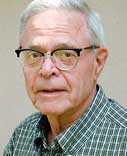John S. King
John S. King, professor emeritus of nuclear engineering, died Aug. 30 at his home in Ann Arbor following a two-year battle with lung cancer. He was 86.

A distinguished nuclear physicist, King’s reputation for innovation in neutron spectroscopy — a powerful tool for viewing the deepest structure of matter — helped earn the Department of Nuclear Engineering its world-class status.
Born in Detroit in 1920, King graduated from Princeton University in 1942 with a bachelor’s degree in political science. In May of that year he joined the U.S. Navy, recruited into the top-secret VT Proximity Fuze project at the Applied Physics Laboratory (APL) of the Johns Hopkins University in Maryland. His skill and enthusiasm caught the attention of APL physicist William Parkinson, who enlisted King in a team of specialists doing classified research through the war years.
APL kindled a lifelong interest in science. After the war King followed his mentor Parkinson to the Physics Department at U-M, where he earned a second bachelor’s degree in two years, moving swiftly on to a master’s degree and then a Ph.D. by 1953. His dissertation on a test of the nuclear shell model presented the results of research at the cyclotron laboratory at the Randall Laboratory. The work, Parkinson notes, represented a significant advance in nuclear physics, earning a mention in Nobel Laureate Maria Goeppert Mayer’s classic book with J.H.D. Jensen, “Elementary Theory of Nuclear Shell Structure.”
In 1953 King accepted a position with the Naval Nuclear Propulsion project at the Knolls Atomic Power Laboratory (KAPL), operated at that time by General Electric. Four years later he was named KAPL’s manager of reactor physics, playing a major role in the birth of the Navy’s nuclear submarine fleet.
King returned to U-M in 1959, invited to join its nascent Department of Nuclear Engineering. Glenn Knoll, an early student who later joined the faculty, recalls the excitement of that period: “John was a driving force in the formative years of the department. Along with fellow faculty Paul Zweifel, Dieter Vincent, Richard Osborn, George Summerfield, Ziya Akcasu, Jack Carpenter, Sam Werner, and a host of very talented doctoral students, he led the effort to establish a world-class neutron scattering program using the new Ford Nuclear Reactor (at the Phoenix Memorial Laboratory). Excellent research was carried out on the structure of polymers and other materials, demonstrating the power of the neutron scattering technique.”
Asked recently what he felt was his best work across his career, he responded, “Three things: nuclear reactor shutdown science (at KAPL), accelerated particle work with the cyclotron and the physics of polymer bonds (at U-M).”
King served as chairman of the Department of Nuclear Engineering from 1974-79, overseeing the complex integration of its scattered facilities into the present Cooley Building. He retired as professor emeritus in 1989.
King is survived by his his friend Joan Matthews of Greenbrae, Calif.; three children, John Jr., Frances and Elizabeth; and by four grandchildren.
A memorial service took place Sept. 21 at St Andrew’s Episcopal Church, 306 N. Division St., Ann Arbor. The family has established the John S. King Memorial Fund, dedicated to the support of research and instruction in the Department of Nuclear Engineering and Radiological Sciences. Contributions (checks payable to “University of Michigan John S. King Memorial Fund”) may be sent to the College of Engineering, Robert H. Lurie Engineering Center, 1221 Beal Ave., Ann Arbor, MI 48109-2102.
Seyhan Nurettin Ege
Seyhan Nurettin Ege, Arthur F. Thurnau Professor and professor emerita of chemistry, died Sept. 13 at her home in Ann Arbor, Mich. She was 76.
Born Jan. 11, 1931 in Ankara, Turkey, Ege spent her early childhood in New York where her father, Ragip Nurettin Ege, represented the Turkish Republic as Cultural Attache to the United States. After returning to Istanbul upon the advent of World War II, Seyhan attended the American College for Girls, graduating with honors.
In 1950 she came to the United States and attended Smith College, receiving a master’s degree in chemistry in 1952 and subsequently earning her doctorate in organic chemistry from U-M in 1956.
After teaching at her alma mater in Istanbul then at Mount Holyoke College, Ege returned to U-M in 1965, and became the first tenured woman and the first woman full professor on the faculty of the Chemistry Department. Her research interests involved the photochemistry of heterocyclic compounds and reactive intermediates in photochemical reactions. She retired from the faculty in 2001.
Ege was a distinguished educator, promoting innovative approaches to teaching chemistry. She authored a textbook “Organic Chemistry: Structure and Reactivity,” which has appeared in five editions between 1984-2004, and has been translated into Spanish, Italian and Chinese. Ege received the Amoco, Phi Lambda Upsilon, and the Chemical Manufacturers Association Excellence in College Chemistry Teaching Awards and was named Arthur F. Thurnau Professor in 1990. A strong advocate for women, she was one of the founders of the Women in Science and Engineering Program at U-M.
Ege is survived by her sister and brother-in-law, Dr. Gunes Ege and Turgut A. Akter of Toronto and relatives in Turkey.
In her honor, the Department of Chemistry has established a fund to create the Seyhan N. Ege Junior Faculty Development Award, which will be used to recognize junior faculty members on their teaching accomplishments. Memorial gifts payable to the “University of Michigan” and noting the “Seyhan Ege Endowment Fund” in the memo should be sent to: Tim Wade, University of Michigan, Department of Chemistry, c/o Seyhan N. Ege Endowment Fund, 930 N. University Ave., Ann Arbor, MI, 48109-1055.
— Submitted by Alice Forney, Department of Chemistry

